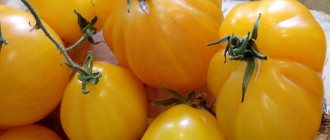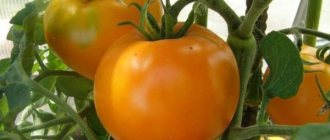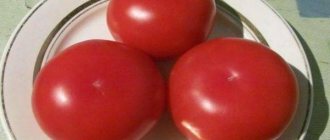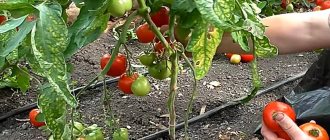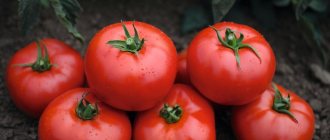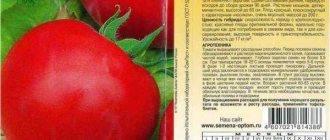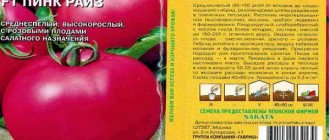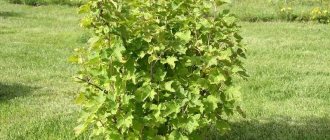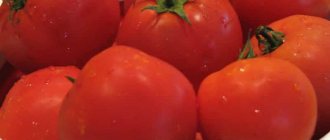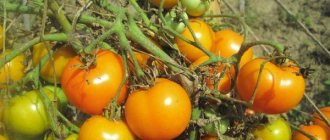The hybrid of Russian selection has been in the register of agricultural achievements since 2008. Suitable for cultivation in open ground and greenhouses, widespread in all regions of the Russian Federation.
| Height | Landing location | Ripening time | Fruit color | Fruit size | Origin | Fruit shape |
| short | Greenhouse, Open ground | Mid-early | Yellow | Large | Variety | Flat-round |
Description and characteristics of the variety
The Golden tomato is positioned as a salad variety. The plant is of a determinate type, no higher than 70-75 cm. Medium-early ripening - 90-100 days. The bush is stocky, the internodes are small. The foliage is dense, dark green, carved.
Tomatoes are hypoallergenic and contain large amounts of sugar, vitamins and fiber.
Inflorescences of intermediate type. Up to 5 fruits are formed on the brush. The tomatoes are large, flat-round, slightly ribbed. The skin is dense, but not thick, rich yellow or orange-yellow in color. The pulp has a pleasant consistency, juicy, aromatic, sweet. The color is uniform and matches the external color of the tomatoes.
Planting seedlings in the ground
Planting seedlings in open soil or a greenhouse begins in early May. Plants should be 30 cm high and have 5-6 leaves. Tomatoes can be grown both in open ground and under film covers. However, a good harvest can only be achieved in greenhouses or greenhouses. Tomatoes grow quickly in well-sunny areas and prefer light soil.
Important! The most favorable neighbors for Golden tomatoes are cucumbers, carrots, cereals and legumes, and cabbage. It is strictly not recommended to plant tomatoes near potatoes, peppers and eggplants.
Small holes are made in pre-prepared soil, where the seedlings are transferred along with a lump of earth. 3-4 tomatoes are planted per square meter. The roots are sprinkled with sifted soil and watered abundantly. It is not recommended to fertilize or water tomatoes for the next week so that the tomatoes can independently adapt to new living conditions.
The Golden tomato is one of the most popular tomatoes among experienced summer residents. Due to its unusual taste and lack of allergenic substances, this variety is often used for the preparation of baby and dietary food. Tomatoes make delicious juices and purees.
Features of cultivation and storage
To extend the fruiting period of determinate tomatoes, they use the formation of a bush into one stem with a “spare” stepson. An additional shoot is left at the level of the 3rd inflorescence; it will grow until the main stem is completed. After 4-5 clusters on the main stem, fruiting is transferred to an additional one.
The soil in the greenhouse is dug up before winter. This reduces the survival rate of pests and pathogens.
Store the harvest in cool, dark rooms at a temperature not lower than 10 ° C and air humidity of 80-85%. In a ventilated room, fruits do not spoil longer. Tomatoes are periodically checked by removing spoiled and overripe specimens, which emit ethylene, a gas that promotes ripening.
Planting seeds
Golden tomato seeds begin to be planted at the end of February or early March. The soil is sifted in advance, fertilized with humus and packaged in special containers. Experts consider cassettes or peat tablets to be the best container for planting seeds, but ordinary plastic cups can also be used. The only drawback of plastic cups is the possibility of damaging the integrity of the tomato root system when planting seedlings in open ground or greenhouses.
Important! The prepared soil for planting seeds must be disinfected in order to eliminate pathogenic bacteria and living pests in the soil. The soil is heated for 20-30 minutes in the microwave or oven. Disinfected soil can be used only after 2 weeks, when beneficial bacteria multiply in the soil.
Before sowing seeds in pots, the grains must first be soaked in a 1% solution of potassium permanganate. Next, the planting material is thoroughly washed under running water and dried until the grains flow. Golden tomato seeds must be planted in containers with a height of no more than 10 cm and a diameter of no more than 6 cm. When using bulk containers, additional picking of seedlings will be required. The grains are placed in the soil to a depth of no more than 0.5 cm. The containers with future seedlings are covered with a film cap and placed in a dark place. The average room temperature should be 18-20C. As soon as seedlings begin to appear in the cups, the seedlings are moved to the windowsill.
Advice! For better seed similarity and faster germination, planting material should be wrapped in a damp cloth for two days. If the fabric is dry, it should be re-moistened.
The main requirements for growing healthy Golden tomato seedlings
- Daily room temperature readings should be from +20 to +24C.
- The night temperature in the room should not fall below +15C.
- Daylight hours are increased to 14 hours.
- Regular, timely watering of seedlings and only with warm water.
The room with seedlings is regularly ventilated, but the plants should not be exposed to drafts. You can increase the duration of daylight hours using lighting. Install phytolamps 30 cm above the level of seedlings.
It is better to water tomatoes with pre-settled water. At this stage, gardeners recommend using a special mechanical water sprayer to reduce the risk of injury to seedlings. When two true leaves appear, the seedlings are planted in separate pots. Elongated and weak seedlings are eliminated. After transplanting the seedlings, the plants are watered once a week.
At the beginning of April, Golden tomato seedlings begin to harden. The first stage of hardening of seedlings is carried out using normal ventilation of the room, after which the container with seedlings is transferred to the balcony. Hardened plants quickly adapt to their natural environment and favorably tolerate transplanting seedlings into open ground or a greenhouse.
Reviews
- Marina from the Moscow region. The Golden King has been one of my favorites for many years now. I grow tomatoes in a small temporary greenhouse located in the country. I cannot provide constant care. Nevertheless, I am harvesting a good harvest of delicious, golden tomatoes. Last season I got a bucket of large fruits from 4 bushes. I like the taste. We eat most of it fresh. I use the rest for juice, but as an addition to the red ones.
- Dmitry from Samara. There are many yellow-fruited varieties growing in my garden. I plant the presented tomato under film. The fruits are large, fleshy, tasty. There is little hassle with plants. To prevent the stems from breaking off under heavy “hearts of gold,” I always tie the bushes to supports. I use only organic fertilizers. At the same time, the harvest is always good.
- Tamara from Crimea. My grandson loves tomatoes, but he is allergic to red vegetables and fruits. For this reason, last season I decided to plant a yellow-fruited variety. I saw the described tomato in a photo online. The color and shape seemed appetizing. I ordered seeds and grew seedlings. In the spring I planted it in an open garden bed. I'm happy with the harvest and the taste too. But the main thing is that our baby ate as many golden fruits as he wanted.
The Golden King didn’t get his name for nothing. The variety occupies a leading position both in the garden and on the table.
Advantages and disadvantages
This variety has a large number of advantages:
- beautiful and tasty bright fruits;
- very fast ripening;
- wide possibilities for consumption;
- one of the best greenhouse varieties.
But it also has quite a lot of significant shortcomings.:
- moodiness and increased care requirements;
- weak immunity and susceptibility to diseases;
- not suitable for northern regions.
Disease resistance and processing
An important characteristic of the “Golden Nugget” variety is resistance to disease. It does not suffer from tomato tobacco mosaic virus, is resistant to tomato bronzing, Alternaria, gray spot, Fusarium wilt, yellow leaf curl virus, and is resistant to spotted and verticillium wilt virus. However, during periods of epidemics, treatment of bushes is necessary for prevention.
See also
Description of the Shasta tomato variety, growing and caring for the plantRead
Tomatoes become more resistant to fungal infections if mineral fertilizers containing potassium, magnesium, and nitrogen salts are used.
You can use folk remedies to achieve a better tomato harvest: wood ash (either a solution or simply dusting the soil under the bushes), bird droppings or mullein (a solution for wet feeding).
What does the plant look like?
The Golden King was bred by Russian breeders more than 10 years ago. During this period, the tomato managed to gain well-deserved popularity among amateurs.
General appearance of the plant:
- Bushes belong to determinants. In suitable conditions, shoots reach 80 cm.
- The tomato is covered with an average number of leaves, sufficient to nourish the plant.
- Flowers of a simple type. The first inflorescence appears above the 3rd node.
- The fruits are heart-shaped. The color is light green. When ripening, the tomato turns yellow.
- The cross-section shows 6-7 chambers. Not many seeds.
- Taste qualities are highly appreciated by tasters. Tomatoes are often consumed fresh.
According to ripening time | By type of growth | By type of use | By growing method | Fruit weight (g) | Yield (kg/m²) | Fruit characteristics |
| Mid-early (85-100 days) | Determinant (70-80 cm) | Salad | For film greenhouses | 100-250 | Up to 10 in a greenhouse; up to 8 in the garden | Heart-shaped, yellow, fleshy |
Harvesting and application
Fruit ripening begins in August. Beds with ripened golden tomatoes in the shape of church domes look very beautiful. Tomatoes should not be allowed to overripe as they may crack. Vegetables can be collected unripe; they will gain color on their own.
Do not forget that ripe vegetables of this variety cannot be stored. The harvest is processed for winter harvesting, and some is left for fresh salads. Moderately juicy and dense, they perform well in lecho, juice, adjika and ketchup. They look original in fresh salads, complementing other vegetables perfectly.
For preparations, select smaller tomatoes so as not to cut them into several parts. And if you dilute orange tomatoes with red ones, then such a technique will be a worthy decoration for any feast. The fruits retain their taste well in barrel pickling.
The absence of tomato juice in fruits indicates a low acidity content, which allows the use of ripe vegetables for dietary nutrition.
Advantages and disadvantages
The strengths of the Golden Stream look like this:
- high yield (up to 10 kg per 1 sq. m);
- ultra early variety;
- low-growing, therefore does not require pinching and shaping (the bushes stop growing tall when they reach the optimal size);
- has strong immunity to diseases and pests;
- withstands temperature changes (bears fruit even in unfavorable weather conditions);
- easily tolerates storage and transportation over long distances.
The variety does not have any particular disadvantages, but some gardeners note that it is often attacked by Colorado potato beetles.
Golden Flow is a hybrid tomato variety that bears plum-shaped fruits of a golden yellow hue. They are distinguished not only by their original appearance, but also by their excellent taste. The variety withstands temperature changes, grows compactly and bears fruit together.
0
0
Copy link
Tomato care
To obtain a good yield, it is necessary to carry out all agrotechnical measures properly.
Watering and loosening
Watering should be abundant and regular, which will help avoid cracking of the fruit. For the first time, seedlings need to be watered 14 days after planting in a permanent place, using settled warm water. In the future, the soil needs to be moistened every 3 days, in the morning or evening. Pour water directly under the root.
On rainy days, there is no need to water the plant at all, since waterlogging of the soil can lead to rotting of the stalk. At the same time, the bed should not be allowed to dry out.
To make the tomato sick less often and develop better, add 2 pinches of wood ash to a bucket of water.
After watering, the soil needs to be loosened according to the following scheme: in the first 3 weeks to a depth of 10 cm, and then - 5-7 cm. The fact is that the roots will gradually develop, and excessively deep loosening of the soil can harm them. After this procedure, the bushes can be earthed up to create a favorable microclimate for the roots.
Ventilation
The greenhouse climate must be constantly monitored to prevent excessive moisture and temperature increases. While it is cool outside, the covering material cannot be removed. In the daytime, its edges should be turned to the leeward side, and at night it should be tightly covered again. The lash can only be removed when stable warm weather sets in.
Top dressing
In order for a tomato to grow and bear fruit normally, it needs to be fed at least 3 times:
- Apply the first fertilizing 14-15 days after planting the seedlings in the ground. The plant should be fertilized with ammonium nitrate (30 g per 20 liters of water) at the rate of 0.5 liters per bush.
- Apply the second feeding when the ovaries form, using superphosphate (15 g) and potassium chloride (7 g). To apply fertilizer, make trenches 5 cm deep along the beds, between the rows, at a distance of 25 cm from the bushes. Distribute the fertilizer evenly in them, and then sprinkle with damp soil.
To ensure better fruit set, the plant should be sprayed with a 0.2% solution of boric acid (2 g per 10 liters to treat 100 sq. m of planting). In bad weather, spraying should be repeated after 2-3 days.
- The third feeding should be carried out during the period of fruit ripening. You can use ammonium nitrate in the same way as the first time. Another option is rotted mullein. It should be filled with water at the rate of 5 kg per 25 liters of water and left for 2 days, and then top up with water (1:20). Water the bushes with the solution at the rate of 1 liter per specimen.
When fertilizing tomatoes, an excess of nitrogen should not be allowed, as this will negatively affect the plant’s immunity and increase the ripening period of the fruit.
Tying to a support
The bushes of the variety are not tall, but each of them should still be tied to an individual stand. Trellis can also be used for these purposes. Thanks to this manipulation, the plant will be able to more easily withstand the weight of the fruit during heavy fruiting. So, the branches will not fall to the ground either in winds or during rain.
If the branches lie on the ground, the plant may be affected by a fungal disease.
Breaking off leaves
To provide good ventilation to the ground under the bush, the lower leaves must be carefully torn off. It should be borne in mind that during the period of plant growth, the leaf plate transfers the necessary nutrients to the fruits, so it should be torn off only in case of infection or yellowing. When the fruits on the first lower cluster are completely filled, the leaves under it can be removed.
As the fruits ripen, the leaves should be removed under each ripe cluster, but no more than 2-3 pieces per week from one plant.
Agricultural technology
Summer residents rarely encounter problems when growing tomatoes of this variety, since the seeds generally germinate without exception, and the yield is 97-100%. However, to achieve such results, it is still worth considering a number of agrotechnical rules:
- Golden stream can withstand short-term unfavorable weather conditions, but requires constant warmth, so it is recommended to cultivate it in a greenhouse or in an open area, but with additional protection.
- Tomatoes need to be grown in seedlings, as stated in the description of the variety. Sow seeds for seedlings 55-60 days before the intended planting in a permanent place. As a rule, this period occurs at the end of March or beginning of April. The sooner you transplant to a permanent place, the sooner you can harvest the first harvest, but to protect the plant from possible frosts, you must use portable film shelters.
- Transplant seedlings to a permanent location only after the soil has warmed to at least +14°C. The optimal temperature during the day is +24°C and above, and at night – not lower than +15°C. It is worth replanting sprouts at the rate of up to 3 plants per 1 square meter. m. The optimal planting pattern for grown seedlings is 50x40 cm.
- When growing Golden Flow in a greenhouse, you need to take into account that the air temperature should not be allowed to rise to +32°C or higher. The fact is that the heat will cause the leaves to curl, and the flowers and ovaries will fall off. So, the crop needs to ensure a harmonious temperature regime, and, if necessary, ventilate the greenhouse.
- The plant does not need to be shaped, but it should be tied to a vertical or horizontal trellis. It needs to be watered regularly and abundantly. During the growing season, it is advisable to feed the tomato 2-3 times, but do not use fresh manure, otherwise the plant will become fattened - the stepsons will grow rapidly, very large leaves will appear, the stems will thicken, but the fruits themselves will set poorly and grow slowly.
